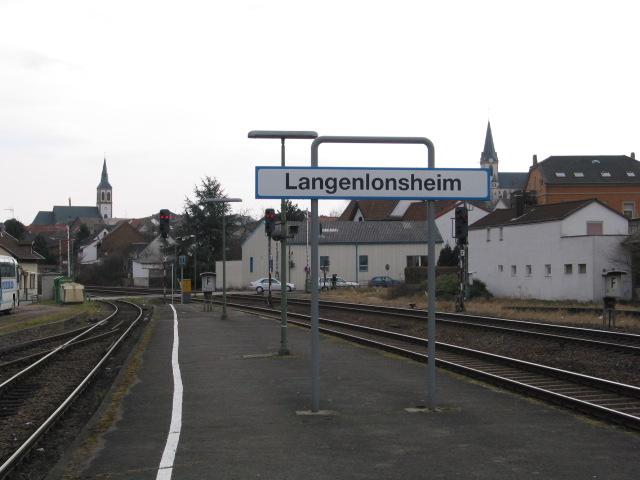
|
After a transatlantic flight to
Frankfurt, I took local trains to Langenlonsheim, a town not far from
the Rhein (Rhine) river. Here's
a picture at the train station.
I wheeled my luggage along the little main street, past shops and homes
that helped me see in just a moment -- exhausted as I was after my
overnight flight across the Atlantic -- that I was definitely in Germany. I met E's
brother at a prearranged spot. He took me to E's old apartment, which
was empty now that E lives with P in another town.
|
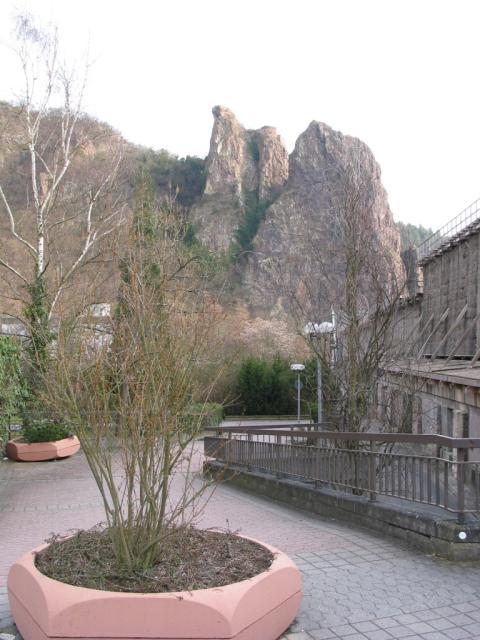
|
I spent the first three days and
two nights on my own, taking trips around the area from a list of E's
suggestions and some maps of the area that he'd left on the table --
and catching up on sleep. Germans love to walk, and I do too. So, to help beat
my jet lag, I stayed up all afternoon. I walked back to the station and
caught a train south to Bad Münster am Stein, a spa town that was
just waking up (so to speak...)
after a long winter. (March is not tourist season in this part of
Germany.) It was a beautiful springlike day, warm and sunny; business
owners were painting and fixing up, and people were out strolling by the
Nahe river.
Here's a view from the town center toward the dramatic cliffs by the
Nahe. On the right you can see a bit of one of the Salinen, a part of this landscape
so unique that they've given the valley its name: Salinental. These are tall frames, stacked with long, thin tree
branches. Mineral-rich water is pumped to the top, where it trickles
down over the branches. Warm summer winds blow through the frame, making
a cool, rich breeze that both residents and visitors take in by sitting
next to the frame on benches and in comfortable chairs. I was here too
early in the year to try it, though. Maybe on my next trip?
|
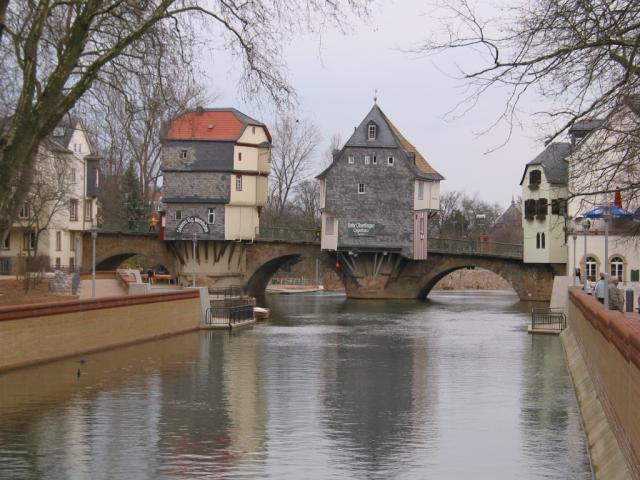
|
I wandered along the river on
the kind of well-marked walking path that (as I found out) is common in
Germany. Some of the trees and bushes were just starting to bud. What a
great way to shake off jet lag!
After a couple of hours, my legs (now getting a little sore...) pulled
me into the city of Bad Kreuznach. It's another summer tourist
destination, with a long riverfront on the Nahe and lots of hotels. One
of the main attractions here are the Brückenhaüser:
houses on a bridge.
After a bit of shopping and some more wandering around, I caught a
train back to Langenlonsheim -- or, the more practical shorter name that
locals use, La-lo.
|
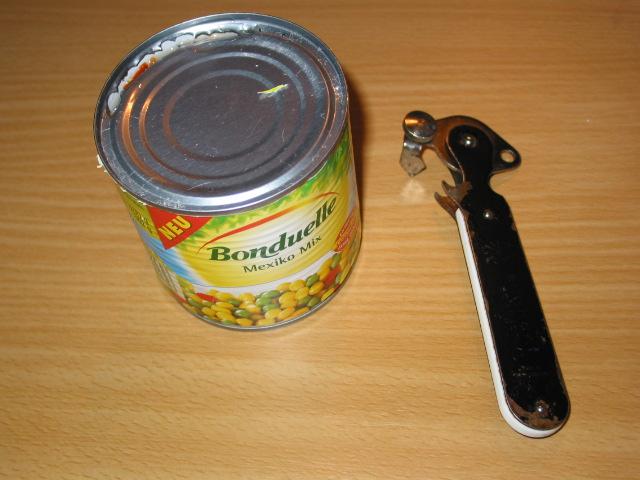 |
One reason I like to travel is
to be surprised and challenged. New experiences make trips interesting
and help me understand a little about life in different parts of the
world. My first day in Germany was full of 'em -- new experiences, I
mean.
This particular experience came late in the day. I'd stopped into a
market for some groceries. When I got home, I checked the cabinets for a
can opener. Hmmm. I recognized the corkscrew (essential equipment in
this famous wine-growing region), but what was this gadget with a
two-part claw and a rotating thingie with a sharp point? Can openers in
the US look very different... could this be one too?? I didn't know
where E's brother lived, my German wasn't up to asking other people in
town, and I didn't know how I could discuss this with P or E over the
phone. So I turned the thingie back and forth, staring at the claw and
looking at the can's lip until, about 15 minutes later, I finally got it
working... sort of. Just don't ask me to describe how to do it! |
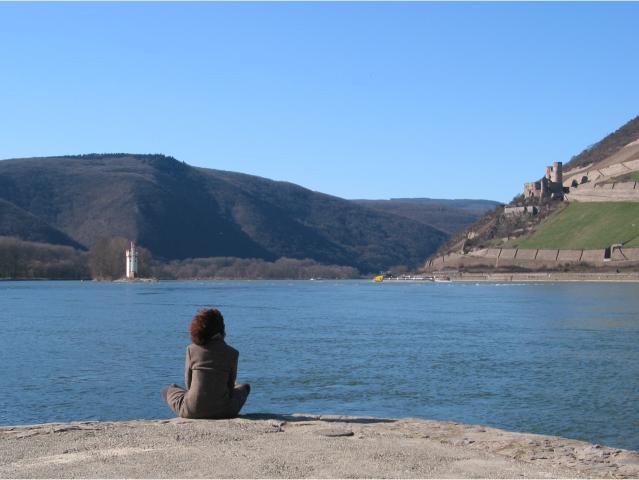
|
The next morning (mostly over my
jet lag, but not quite...) I walked back along La-lo's little main
street to the station, where I caught a train north to the city of
Bingen. Bingen is on the Rhein, that famous river full of all kinds of
boats and barges, running through a valley carpeted with vineyards and
old castles. The air was cold and crisp, which made it a good day for a
walk -- or for some time sitting by the river (if you had a coat that's
warm enough, that is).
Click on this picture to get a better view of the "mice tower"
(Mäuseturm),
a tiny castle on a tiny island -- as well as that bigger
castle above the right bank (and the train along the bank, and the barge
on the water, of this busy river).
|
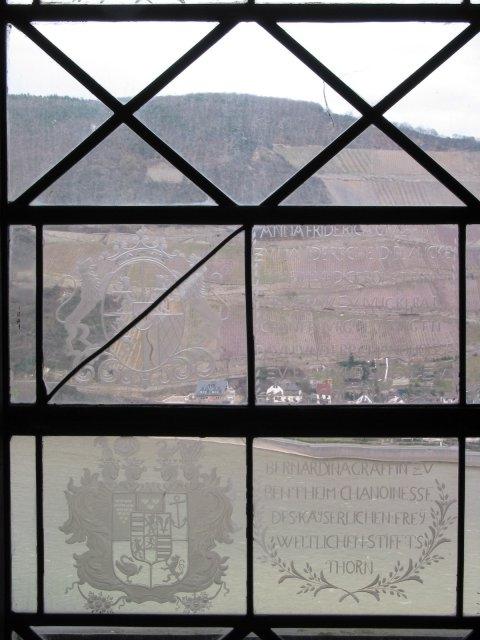
|
The wanderweg (footpath) took me along
the left bank of the Rhein -- which was in the morning shadows, so it
was even colder! -- to the Burg
Rheinstein, the Rhinestein castle. After a long series of former
owners, its current owners -- a family -- bought the castle in the
1970s and have done a wonderful job of restoring it.
The self-guided castle tour let me spend as long as I wanted... which I
did! I took a few hours to explore the nooks and crannies, to see the
hundreds of hunting trophies on the walls, the paintings, furniture,
displays of armor, and the great views over the Rhein (until the cold
winds drove me back inside the castle's thick walls...). This view is
through one of the beautiful etched and stained-glass windows that line
one wall of a series of rooms. Through the old panes, you can see the
hills across the valley and the water below.
|

|
After a third day of walks, I
took a train south to meet my friends at their new home: a large flat in
a town halfway between the cities where each of them work.
In the morning, P took me to Trier, the city where she works. It's
an ancient city, settled thousands of years ago, with everything
from Roman ruins to interesting new buildings and artwork.
This statue, at the southern end of the city's central pedestrian zone,
was no exception.
I didn't know the story when I was there.
Rainerius, the Boogieman, from Trier, saw this photo and sent me the story:
It's the Heuschreckbrunnen, the Grasshopper fountain.
These are original citizens of Trier,
who made a lot of jokes with the other people on
Karnelval or Fastnacht, which is a party like Halloween.
I liked the
flavor it added to this rich city full of interesting sights.
Although I walked all day, I didn't have enough time to see more than
just a few parts of Trier.
|
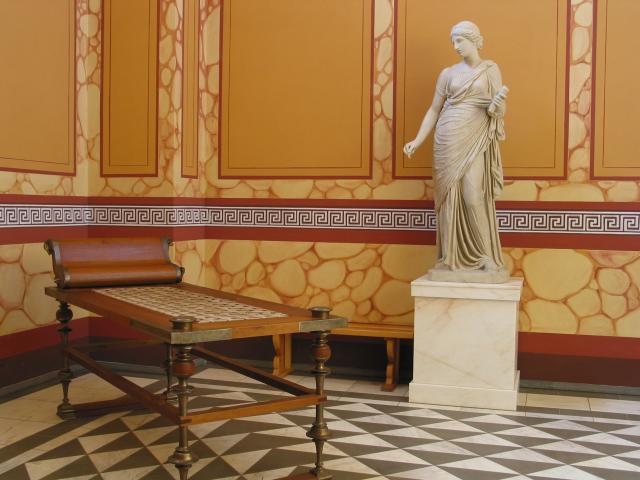
|
On Saturday we took another
drive across the rolling hills toward Germany's border with Luxembourg
and France. First stop: the Villa Borg. It's a restored Roman villa,
built from the ruins of a home on land that a soldier was granted for
his service to Rome in this (then) colony. The restoration is still in
progress, but the results are already fantastic. Instead of the
faded-but-intact ruins you'd see at a place like Pompeii, in the Villa
Borg you see things as they would have been 2000 years ago: freshly
painted and beautiful. There's a museum with artifacts found in the area
(including ones from times before and after the Romans), manicured
gardens, and a pool. The Villa's staff will even cater Roman meals --
including togas for all of your guests, if you want. It's quite a place.
|
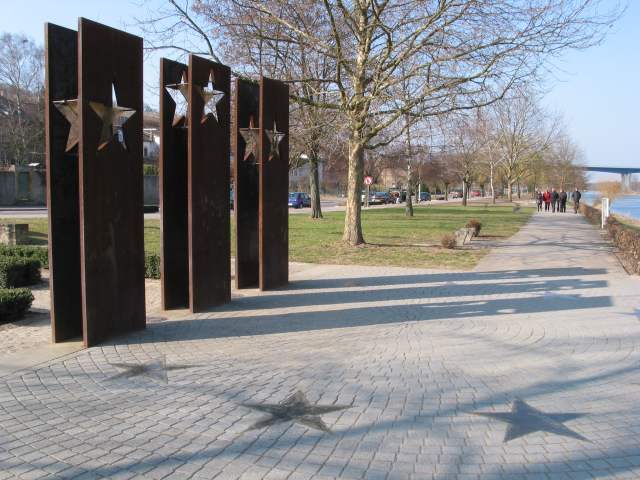
|
Back in the car, we crossed the
border into Luxembourg. There was no customs post or border inspection,
just a deep blue sign with a circle of gold stars and the country's name
in the middle. The monument in this picture, with six pillars and six stars, is along
the river next to the international bridge.
Unlike the USA, which is fortifying its borders with Canada and Mexico,
much of Europe has open borders -- thanks to the agreement that
was first signed in this Luxembourg town named Schengen. The original
six countries chose Schengen because it's in a corner of Europe where
three countries (Germany, France and Luxembourg) meet. Although not all
European countries are part of the agreement, what happened in this town
has helped to make life easier for residents and tourists alike. After
a walk around the pretty town, my friends stocked up on coffee and
gasoline (which are cheaper here than in Germany) and we drove back to
their home for one more delicious home-cooked German meal.
The next day I was on
an overnight train to Austria. I slept as we crossed the border --
instead of waking up to show my passport -- thanks to the European
agreement that started in Schengen. |









